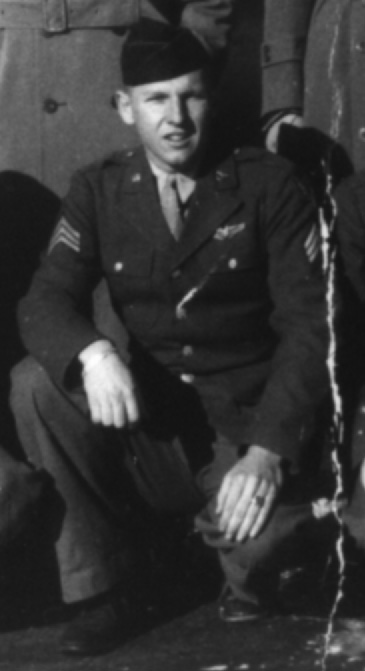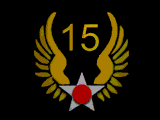|
|
Sgt. Stratton W. Beesley
720th Squadron

|
Stratton W. Beesley was born in Ponca City, Ok. on 16th June 1922. he enlisted in the U.S.A.A.C. at Goodfellow Field, Texas on 18th June 1942.
His cadet training was at the training center in San Antonio, Texas, class 43-I, Primary at Coleman, Texas, Gunnery School at Tyndall Field, Florida, Armorer School at Lowry Field, Co.
His first crew under 2nd Lt. Oscar Anderson, was formed in Tonopah, Nevada and in late 1943 they picked up a new B-24 at Hamilton Field, Ca. From there they flew to
West Palm Beach , Florida by way of Phoenix, Az., Midland, Tx. and Memphis, Tenn.
After a few days in West Palm Beach it was off to Manduria, Italy via Trinidad, Belem, Brazil, Forteleza, Brazil, Dakar, Africa and Marraketch, Morroco.
After arriving in Manduria, the crew was split up and assigned to fly several missions with experienced crews, before flying together in combat.
On 29th April 1944 while flying aircraft 41-29269 on their 11th mission, to bomb a U-Boat base in Toulon, France, the crew encountered heavy flak and were shot down and forced to
ditch 75 miles from the French coast in the Mediterranean Sea. Stratton was in the tail turret and moved into the waist gun area to help crank up the ball turret and retrieve the ball turret gunner,
Cpl. Bill Gernhauser. When the aircraft crashed he was knocked unconsscious. He soon found himself underwater, confused and entangled in the wreckage. Fortunately, he surfaced and was able
to inflate his Mae West. The aircraft was still afloat, so Stratton and Radio Operator, Sgt. Fred Beck, crawled onto the wing and released the two, five man rafts that the B-24 carried.
All 10 crewmen managed to make it to one of the rafts. Navigator, 2nd Lt. Preston McKart was seriously injured. The crew was without food and water, drifting in the Mediterranean Sea. Lt. McKart
appeared to have a broken back, sustained when the Martin Top Turret fell on him during the crash. Without medical knowledge and with very limited resources the crew did what they could to comfort Mac
for two days before he passed away.
Not knowing how long they would be adrift at sea, or if any of them would survive, the crew made the unanimous decision to bury Mac at sea. This was a traumatic undertaking for the crew, but with prayer
book in hand, they paid their last respects to a dear friend.
On their third day in the life raft they were spotted by a German aircraft which they signaled with flares. The pilot of the small plane signaled he had seen them and would send help.
Several hours later, they were picked up by a German amphibious aircraft and were shuttled back to the Toulon - Marseille area of France.
Stratton and Bill Gernhauser were seperated from the other six men and sent to a German controlled hospital in Toulon. Bill had a severely injured leg and Stratton a cut from his nose to the top
of his head.The two men laid side by side for two weeks in the hospital before Stratton was transferred to a Paris hospital. Stratton never saw Bill again. He did learn months later that Bill had
his leg amputated and was a P.O.W. for a year before being repatriated.
Stratton remained in the Paris hospital for about three days before being sent to Frankfurt for interegation. He was kept in solitary confinement for three days before being shipped in a 40 x 8 boxcar to
Stalag Luft IV, B Lager (nicknamed "Buck")
Stratton remained in Stalag Luft IV until early February 1945. He clearly remembers an incident they named "Big Stoop". The nazi's lightning strike on the British Huts and individual being shot from
a barracks window by a German guard. In February, when the Russian army started moving from the Eastern front towards Berlin he began the well recorded 86 day "Death March" from Stalag Luft IV, North,
towards Stettin on the Baltic Sea. For P.O.W.'s like Stratton it meant being cold, wet, tired and hungry. Men suffered from frostbite, swollen feet, dysentry and malnutrition. Many died during the forced march.
After five or six weeks, sleeping in barns, Stratton became ill and could no longer walk. He was hospitilized in a large barn with several other men. He and the others were cared for by a flight surgeon,
Cpt. Leslie Caplan, who was also imprisoned at Stalag Luft IV. Stratton was informed he had Diphtheria and would be put on the "Slow Party" with the Captain and other sick men. Stratton's march
continued on the back of a horse drawn cart.
After several days on the cart and resting in barns under Captain Caplan's care, Startton was once again able to walk. Had it not been for Captain Caplan, Stratton is sure he would not have
survived the "Death March".
Several days after starting to walk again, some distance South of Hamburg near Luneburg, some several hundred miles West of Stalag Luft 4, all of the German guards disappeared.
Sgt. Joseph Smith from Derby, Pa., a room mate of Stratton's from Stalag Luft 4, joined up with three British enlisted men who had been imprisoned since the invasion of Dunkirk.
The five men hid in barns for about three days before waking to the sound of gunfire and heavy vehicles near by. One of the Brits went to investigate and came back to describe a small military vehicle
he had never seen before.
That vehicle turned out to be an American Army Jeep. We had been overrun by the British 11th Armored Division. We were finally free men again. From Germany Stratton was transported to
Holland then England on a Lancaster Bomber. He was a RAMP in London before sailing from Southampton for the USA aboard the Kungsholm. He arrived at Camp Shanks, New York,
and took a train to San Antonio on 1st June 1945.
Stratton Beesley participated in the following campaigns:
Rome Arno, Southern France, Air Offensive Europe and Air Combat Balkans. His decorations include the Good Conduct Medal, EAME with 4 bronze stars, the Purple Heart, two overseas bars
and a POW medal.
After returning State side he was married on 29th July 1945, graduated from the University of Texas at Austin in 1949, was a geophysicist for Shell Oil, vice president of Precision Cable and
Directeur General of Societe Algerienne De Recherches et D'Etudes Geophysiques in Algiers, Algeria. He presently owns and operates a company "Dedicated to the exploration and development of petrolium lands" in Texas.
He has a son who is an engineer at Boing and a daughter who is a marketing manager for a hospital, four grandchildren and one great grandchild.
|
Pictures & Information provided by Stratton W. Beesley, 720th Squadron
|



